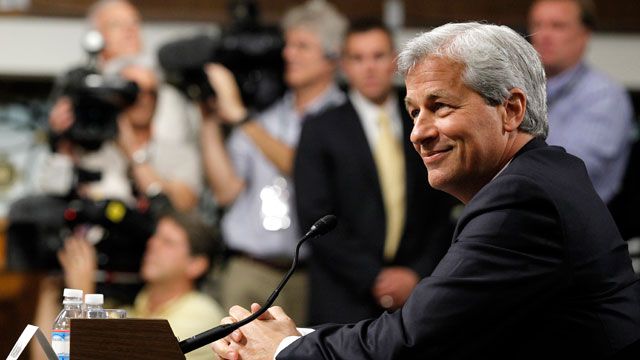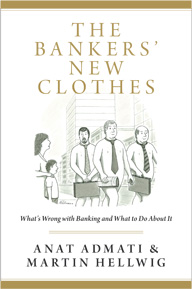
Excerpted from The Bankers New Clothes: What’s Wrong with Banking and What to Do about It by Anat Admati and Martin Hellwig.
Although they can put in place any laws and regulations that they see fit, politicians are not in the driver’s seat in their relation with banks. Bankers know more about banking than politicians. Moreover, politicians want the bankers’ cooperation to make the investments the politicians favor — or campaign contributions. When bankers warn that capital requirements will hurt bank lending and reduce economic growth, they are rarely challenged by politicians, not only because politicians do not see through the banks’ claims but also because they do not want to upset their symbiosis with bankers.
 Bankers and politicians have a two-way dependence. In this situation, politicians can forget their responsibilities, and the political system fails to protect the economy from banking risk. Even after the financial crisis, as one politician admitted, the banks “own the place.”
Bankers and politicians have a two-way dependence. In this situation, politicians can forget their responsibilities, and the political system fails to protect the economy from banking risk. Even after the financial crisis, as one politician admitted, the banks “own the place.”
The three decades leading to the financial crisis of 2007–2009 were marked by enormous growth in the financial sectors of the United States and Europe. Banks and financial firms convinced politicians and regulators that tight regulations are not needed because markets work well enough. Bankers gained prestige and wealth and their political influence increased. An anti-regulation ideology helped as well.
Prior to the financial crisis, regulators failed to set proper rules and supervisors failed to enforce the rules in place so as to prevent the reckless behavior of bankers. In the United States, for example, Alan Greenspan (chairman of the Federal Reserve), Arthur Levitt (chairman of the Securities and Exchange Commission [SEC]) and Robert Rubin (treasury secretary) prevented an initiative in 1998–2000 that would have imposed more transparency on derivatives markets. Such transparency was sorely missing in the run-up to the financial crisis. A 2004 ruling of the SEC allowed US investment banks to determine their regulatory capital on the basis of their own risk assessments, and this enabled Lehman Brothers and other investment banks to become highly indebted and vulnerable. The United Kingdom also instituted so-called light-touch regulation in order to expand its role as a major financial center.
An important factor underlying the financial crisis of 2007–2009 has been the failure of regulators and supervisors in the United States and in Europe to set and enforce proper rules to prevent the reckless behavior of bankers. Supervisors in the United States and Europe allowed banks to circumvent capital requirements by creating various entities that did not appear on the banks’ balance sheets. Investors were willing to lend to these entities because the sponsoring banks were providing guarantees. The supervisors did not object to banks’ keeping these exposures off their balance sheets, nor did they try to limit the banks’ obligations from the guarantees. The obligations ended up greatly weakening the sponsoring banks and bankrupting some of them when the crisis broke in the summer of 2007.
What causes regulatory capture? First, regulating and supervising an industry requires some expertise. This expertise is best found among people in the industry. Regulators and supervisors therefore tend to have significant numbers of recruits from the industry. If these people are competent, they may eventually be hired back by the industry. In such a revolving-door situation, a regulator may start out with some sympathy for the bank that he or she has just left. Also, regulators may not want to be tough on banks from which they hope to receive job offers in the future.
In the United States, bankers serve on the boards of the regional Federal Reserve banks, which are in charge of supervising banks and even in setting the regulations. For example, Jamie Dimon, CEO of JPMorgan Chase, has been on the board of the Federal Reserve Bank of New York since 2007 and will serve through 2012, even as the New York Fed is directly involved in formulating and enforcing capital regulations and other policies impacting JPMorgan Chase and other banks. This situation can create significant conflicts of interest.
Second, regulators exhibit what is known in sports as the home-team bias of referees, the subconscious sympathy of referees for the team that is cheered by the home crowd. If the crowd of onlookers, such as segments of the press, politicians and industry specialists, favor certain people and institutions, supervisors may become biased and favor them as well. The home-team bias is particularly strong if the affected firms claim that a regulation unfairly
damages their ability to compete with away teams, firms in other countries.
In this context, it is important to realize that special interests tend to be much more vocal than the general public. As regulation matters greatly to them, so they invest heavily in lobbying. To any individual without a special interest, the regulation may seem too unimportant to warrant much of an investment of attention or energy. Even if, in the aggregate proper enforcement of the regulation would be called for, because so many people are affected, special interests that fight the regulation may have much more influence.
Third, firms in the industry influence politicians and administrators by lobbying and by providing money, particularly for election campaigns. Firms in regulated industries want to make sure that appointees to regulatory positions will not be too challenging. Top bankers and politicians interact in many informal ways as well. For example, Jamie Dimon cultivates his relations with high-level government officials and has stated that JPMorgan Chase gets “a good return on the company’s ‘seventh line of business’ — government relations.” If a regulatory agency is zealous in trying to control the industry, the legislature can cut the agency’s budget to restrain the zeal.
In other industries, the effects of regulatory capture might be weakened by resistance from the firms’ clients and competitors, the public and politicians. For example, safety standards that would allow a risk of plane crashes would not be tolerated for long. The harm is evident, and it is easy to trace damage back to negligence and recklessness.
In banking, however, the damage from ineffective regulation and supervision is harder to detect. Moreover, for the reasons we discussed earlier, politicians may find it quite appropriate or convenient for regulators and supervisors to be lax toward banks. The public is dispersed and disorganized, and other individuals and firms have little to gain individually from pushing banking reform. Everyone has dealings with banks, and many find it beneficial or necessary to maintain their good relationships with the banks. In this environment, confusing and flawed arguments — the bankers’ new clothes — are more likely to affect policy. This situation can change only with significant pressure from the public. Nonprofit citizens’ and public-interest groups try to provide a counterweight to lobbying by industry groups, but their resources can hardly compete with those of the financial industry, and they often find it difficult to gain access to politicians and regulators.
An interesting comparison can be made with the Japanese authorities that were in charge of supervising the Tokyo Electric Power Company (TEPCO) before the earthquake and tsunami on March 11, 2011. According to the parliamentary committee investigating the nuclear disaster at the Fukushima Daiichi Nuclear Power Plant after those events, the disaster could have been avoided if the supervisor had been more diligent in imposing safety rules and the company had been more forthcoming in complying.
In what the report on the nuclear disaster calls a “culture of complacency,” the behavior of TEPCO and its supervisors was shaped by collusive ties among the nuclear industry, regulators and politicians. Regulators allowed TEPCO to operate reactors that were known to have significant problems, and TEPCO was able to hide some problems that were even more serious. Regulations were nonexistent or inconsistent or were not enforced. The individuals involved seemed more concerned with their own interests than with the safety of the plants. The so-called nuclear power village represented revolving doors and a web of connections among government officials, regulators and TEPCO. The reports about the regulatory and political environment that emerged in the context of TEPCO show a striking similarity to the situation of the financial industry. In both cases, regulatory and political capture went unchecked, and still does, because the risks were hidden — until disaster struck.
Much is wrong with banking, and much can be done about it. If politicians and regulators fail to protect the public, they must face pressure to change course.



